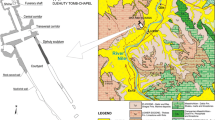Abstract
Bulk samples of mortars were collected from archaeological sites dated from Hellenistic to Roman period in order to investigate the technological evolution of historic structures from simple lime based systems to advanced hydraulic materials. Roman opus caementicium enabled the construction of vaults with a mechanical behaviour of an inert monolith; the rapidly hardened mortar with its concrete-like strength provided a monolithic effect on lighter vaulted structures. The samples were characterized in terms of their isotopic, chemical and mineralogical composition. Stable isotope analysis (13C and 18O) provided information relative to the origin of CO2 and water during calcite formation making possible to distinguish different mortar technologies. The results of micro-morphological and petrographic examination elucidate the technological continuity of historic mortars. Hellenistic mortars are composed of lime enhanced with quartz aggregates. Roman mortars are composed of lime, pozzolan and various aggregates such as quartz, feldspar, ceramic and rock fragments. The isotopic values comprise a range of δ13C and δ18Ο values from −17.6‰ to 3.6‰ and −25.9‰ to 0.4‰ very different from that of local limestones used for mortar production. This study indicated that stable isotope analysis is an excellent tool to fingerprint the origin of carbonate and therefore indicate the variations in mortar’s technology.
Access this chapter
Tax calculation will be finalised at checkout
Purchases are for personal use only
Similar content being viewed by others
References
Dietzel, M., Usdowski, E., Hoefs, J.: Chemical and 13C/12C and 18O/16O-isotope evolution of alkaline drainage waters and the precipitation of calcite. Appl. Geochem. 7, 177–184 (1992)
Dotsika, E., Psomiadis, D., Poutoukis, D., Raco, B., Gamaletsos, P.: Isotopic analysis for degradation diagnosis of calcite matrix in mortar and plaster. Anal. Bioanal. Chem. 395, 2227–2234 (2009)
Dotsika, E., Kyropoulou, D., Christaras, V., Diamantopoulos, G.: δ13 C and δ18Ο Stable isotope analysis applied to detect technological variations and weathering processes of ancient lime and hydraulic mortars. Geosciences 8(9), 339 (2018)
Hutcheon, I., Abercrombie, H.: Carbon and dioxide in clastic rocks and silicate hydrolysis. Geology 18, 541–544 (1990)
Lamprecht H.O.: Opus Caementicium, Beton – Verlag, pp. 21–40 (1984)
Lechtman H.N., Hobbs L.W.: Roman concrete and the Roman architectural revolution, ceramics and civilization VII: high technology ceramics, past, present and future, the nature of innovation and change in ceramic technology, Kingery (eds), American ceramic society Inc, USA, pp. 81–128 (1986)
MacDonald W.L.: The architecture of the Roman Empire, pp. 152–168. Yale University Press (1965)
Malacrino C.G.: Constructing the ancient world. Architectural techniques of the Greeks and Romans, pp. 72–137. Getty Publications (2010)
Robertson, D.S.: A Handbook of Greek and Roman Architecture, pp. 147–266. Cambridge University Press (1959)
Taylor R.M.: Roman Builders. Α Study in Architectural Process, pp. 175–178. Cambridge University Press (2003)
Usdowski, E., Hoefs, J.: Oxygen isotope exchange between carbonic acid, bicarbonate, carbonate, and water: a re-examination of the data of McCrea (1950) and an expression for the overall partitioning of oxygen isotopes between the carbonate species and water. Geochimica and Cosmochimica Acta 57, 3815–3818 (1993)
Wright, G.R.H.: Ancient building technology, pp. 115–116. Historical Background, Brill (2000)
Author information
Authors and Affiliations
Corresponding author
Editor information
Editors and Affiliations
Rights and permissions
Copyright information
© 2022 The Author(s), under exclusive license to Springer Nature Switzerland AG
About this paper
Cite this paper
Kyropoulou, D., Heliades, E., Karalis, P., Diamantopoulos, G., Gougoura, S., Dotsika, E. (2022). Technological Evolution of Historic Mortars: From Lime-Based Mortars to Roman Opus Caementicium. In: Vayas, I., Mazzolani, F.M. (eds) Protection of Historical Constructions. PROHITECH 2021. Lecture Notes in Civil Engineering, vol 209. Springer, Cham. https://doi.org/10.1007/978-3-030-90788-4_8
Download citation
DOI: https://doi.org/10.1007/978-3-030-90788-4_8
Published:
Publisher Name: Springer, Cham
Print ISBN: 978-3-030-90787-7
Online ISBN: 978-3-030-90788-4
eBook Packages: EngineeringEngineering (R0)




